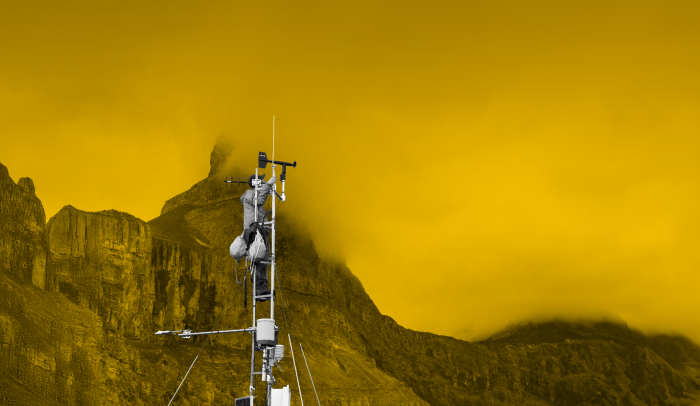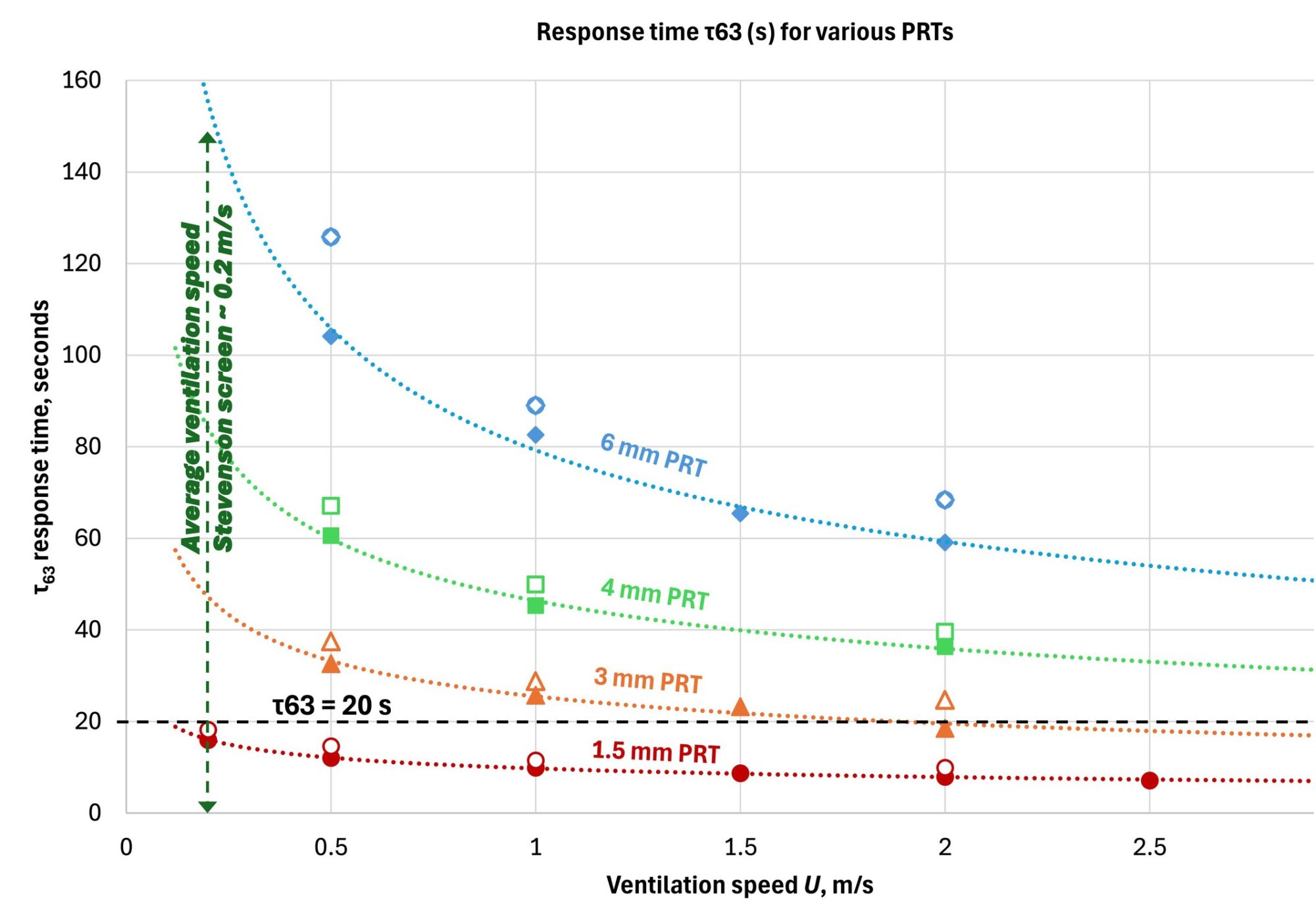The 0.1°C Challenge: The Heat on Temperature Sensors that Meet WMO Recommendations
by Aspen Nielsen | Updated: 08/22/2025 | Comments: 2

Whether you’re tracking climate change, assessing floods, monitoring glacial retreat, or making critical decisions about aircraft take-offs, temperature data play a central role. Air temperature directly influences a wide range of atmospheric and environmental conditions, including humidity, pressure, and wind patterns. Accurate temperature measurements are essential not only for real-time decision-making, but also for long-term climate monitoring and scientific research.
But here's the catch: currently, different temperature sensors used globally create inconsistencies, which introduce questions about data accuracy, defensibility, and comparability.
In this blog article, we will explore World Meteorological Organization (WMO) guidelines for temperature measurement, discuss the engineering challenges involved to meet the recommendations, and highlight proven solutions that meet or exceed WMO suggestions, raising the benchmark for temperature sensing around the world.
The Challenge: Meeting WMO Temperature Recommendations
The United Nations’ WMO developed recommendations for various environmental and climate sensors, including temperature sensors. Historically, both engineering challenges and extraordinarily high costs were associated with trying to meet or exceed WMO temperature measurement guidelines. Fortunately, recent advancements have made meeting WMO measurement guidelines possible, accessible, and affordable.
Why do WMO recommendations matter?
Accurate temperature data are foundational to a wide range of measurement systems, decisions, and policy-making processes. As the global climate continues to change, advancing climate science depends on high-quality data—data that are standardized, traceable, defensible, and accurate.
Unfortunately, around the world, sensor specifications for weather and climate data are highly variable, which makes it nearly impossible to create consistent and comparable numeric models from inconsistent data. Better data are needed for better forecasting models.
Because of the global need for high-quality data to feed high-quality models, the WMO established rigorous guidelines for environmental monitoring systems. Despite this, many commercially available temperature sensors have struggled to meet these standards.
For years, finding a temperature sensor that could deliver both low measurement uncertainty and a short time constant across broad temperature and wind ranges was virtually unattainable. This left researchers searching for solutions that could fulfill the WMO’s performance expectations—standards that represented serving the public good through better data.
Although meeting WMO standards is not required in all regions, their recommendations are widely regarded as the benchmark for temperature measurement quality. These guidelines represent a collaborative, global effort to create unified standards that enable temperature data to be accurate, defensible, comparable, and scientifically robust.
WMO standards (found in WMO-No. 81 and summarized later in this article) are important for several reasons:
- Accuracy and Traceability – Sensors that meet WMO guidelines adhere to strict recommendations for accuracy, stability, and calibration traceability. In turn, this reduces measurement uncertainty, especially in extreme conditions.
- Global Data Comparability – WMO standards ensure that measurements taken across the globe are comparable and consistent. Without standardization methods and sensor specifications, temperature data from one station might not align with another, making it difficult to assess regional or global trends.
- Quality Control in Climate and Weather Records – Long-term climate datasets—often used to understand climate, validate models, or support policymaking—depend on high-quality, standardized observations. Following WMO guidelines helps ensure the integrity and defensibility of these records.
- Designed for Real-World Conditions – WMO standards take into consideration real deployment factors to ensure environmental durability, not just lab conditions.
Ultimately, meeting WMO guidelines is about more than just a label. It’s about ensuring durability, dependability, and accuracy when measurements matter most.
What are the technical recommendations for sensors that meet WMO guidelines?
To adhere to WMO guidelines, temperature sensors must meet specific criteria, as found in WMO-No. 8, chapter 2. Here’s a summary:
| Temperature Sensor Feature | WMO Standard |
|---|---|
| Measurement Uncertainty | ±0.1°C or better |
| Measurement Range | -80° to +60°C |
| Calibration | Traceable to national/international standards |
| Time Constant | ≤20 s |
After WMO-No. 8 was released, the WMO created a supplementary Instruments and Observing Methods Report, IOM 136, which further clarified their standards. IOM 136 defined the “achievable accuracy” tolerance for temperature measurements at ±0.2°C or better.2 Achievable accuracy refers to the accuracy that can practically be achieved with high-quality instrumentation and procedures after external factors have been accounted for.
At the core of accurate temperature measurements is a sensor that meets or exceeds WMO-achievable accuracy recommendations. Even in well-managed installations, real-world factors can add onto small sensor inaccuracies and risk pushing the entire measurement outside of the acceptable ±0.2ºC tolerance. Because of this, carefully selecting sensors that meet or exceed the ±0.1ºC specification—especially when paired with a proper installation and use of a high-quality, compatible radiation shield—greatly increases the chance of meeting or exceeding the WMO IOM 136 recommendation for ±0.2ºC achievable uncertainty.
Sensors that Meet the Standard
Finding affordable, commercially available temperature sensors that meet or exceed WMO recommendations has long been a challenge. To address this gap, Campbell Scientific introduced two advanced sensor designs to meet WMO guidelines: the TempVue™10 and the TempVue™20.

Both TempVue models meet WMO standards as stand-alone sensors, offering measurement uncertainties of ±0.1°C across ranges of -80° to +60°C for the TempVue 10, and -40° to +40°C for the TempVue 20. These ranges cover nearly all ambient air temperatures typically encountered in global meteorological applications.
All TempVue models are delivered fully calibrated, with certification traceable to national standards. The accuracy level is made possible through key engineering choices, including minimizing thermal conductivity in the sensor body, isolating the platinum resistance thermometer (PRT) tip, and incorporating light-colored cabling to reduce radiative errors.
“The TempVue series sets a new standard in meteorological-grade temperature sensing,” said Chod Stephens, a technical product manager at Campbell Scientific.
Meeting WMO Standards for Time Constants in Stagnant Air
The time constant plays a vital role in air temperature measurements, whereby a shorter time constant allows sensors to respond more quickly to atmospheric changes, enhancing both performance and data quality.
As Dirk Baker, manager of Campbell Scientific’s Global Science Program, explained, “Air temperature is one of the most critical measurements for weather and climate. While scientists and manufacturers are continuously making improvements, there remain vital aspects where improvements are needed. One of these is how quickly a sensor responds to changes in the ambient conditions. This is quantified as the time constant.”
Baker added, “The sensors currently in use around the world vary widely in their time constant. Slower time constants lag behind changes in ambient temperatures, leading to error and uncertainty that can be substantial. These differences in time constant, error, and uncertainty further complicate comparing data across observation sites, networks, and historical data. The WMO recommends a time constant of 20 seconds or less. However, very few commercially available sensors for weather and climate meet this requirement.”
Most temperature sensors being used globally, regardless of type (liquid-in-glass, analog, digital, etc.) fail to meet or exceed WMO time constant recommendations in real-world wind conditions. In practice, this means that they are unable to detect rapid changes in ambient conditions, especially in stagnant or low wind conditions.
From "Improved time constant of a newly released air temperature sensor and its implications" (Burt and Baker, 2025). Used with publisher permission.
Click the graph for a larger image.
According to the peer-reviewed study Improved time constant of a newly released air temperature sensor and its implications,3 the TempVue 10 is among the first commercially available sensors that can meet, or exceed, the WMO’s time constant target of 20 seconds. The study’s authors, Burt and Baker, validate that the TempVue 10 (1.5 mm) sensor demonstrates a significantly shorter time constant compared to leading Stevenson-type sensors with larger diameter PRT tips (3 mm, 4.5 mm, and 6 mm).
Raising the Standard in Temperature Sensing
“Sensor providers should be raising the bar and holding ourselves to a standard where we can accurately measure 0.1°C or better temperature changes,” commented Stephens. As the demand for accurate, traceable, and standardized climate data grow, the importance of meeting WMO guidelines in temperature sensing can’t be overstated.
Whether you’re building a research-grade weather station or supporting long-term environmental monitoring, the sensor you choose must do more than just report a number; it must meet rigorous, globally recognized standards.
The TempVue 10 and 20 represent a new era of accessibility in high-precision meteorological measurement capability. With proven performance, calibration traceability, and adherence to WMO guidelines, they offer confidence in every degree—or tenth of a degree—you measure.
Learn more about our TempVue 10 Pt100 Analog Temperature Sensor or TempVue 20 Pt100 Digital Air Temperature Sensor.
Credits: Chod Stephens and Dirk Baker of Campbell Scientific, Inc. contributed to this article.
References
1 World Meteorological Organization. (2025) Guide to instruments and methods of observation. Available from: https://library.wmo.int/records/item/68695-guide-to-instruments-and-methods-of-observation?offset=3.
2 Body, D. and Kuik, F., (2021) Generic automatic weather station (AWS) tender specifications. Geneva: WMO.
3 Burt, S.D. and Baker, D.V. (2025) Improved time constant of a newly released air temperature sensor and its implications. Quarterly Journal of the Royal Meteorological Society, e4996. Available from: https://doi.org/10.1002/qj.4996.
















 Aspen Nielsen is a marketing specialist at Campbell Scientific, Inc., where she focuses on creating customer-centered campaigns, delivering meaningful content through data-driven analytics, and supporting cross-functional teams. She joined the company in 2022 and stepped into her current role in 2025 after earning her MBA from Western Governors University. When she’s not working, Aspen enjoys hiking in the mountains, painting landscapes, reading novels, and spending time with her beloved cat, Nova.
Aspen Nielsen is a marketing specialist at Campbell Scientific, Inc., where she focuses on creating customer-centered campaigns, delivering meaningful content through data-driven analytics, and supporting cross-functional teams. She joined the company in 2022 and stepped into her current role in 2025 after earning her MBA from Western Governors University. When she’s not working, Aspen enjoys hiking in the mountains, painting landscapes, reading novels, and spending time with her beloved cat, Nova.
Comments
Muhammad Muzzamil | 08/27/2025 at 07:44 AM
When deploying an Automatic Weather Station (AWS), accurate measurement of both temperature and relative humidity (RH) is essential. While the TempVue20 can achieve ±0.1 °C accuracy for temperature, it does not provide RH measurements. For this purpose, sensors such as the HygroVUE5 or HygroVUE10 are required.
It would be highly beneficial if future versions of the TempVue20 could integrate an RH sensing element—providing precise temperature measurements via the PT100 sensor and RH data via a separate dedicated chipset. Otherwise, an additional ambient air/RH sensor must always be installed alongside the TempVue20.
Aspen Nielsen | 09/08/2025 at 02:49 PM
Hi Muhammad,
Thank you for your thoughtful comment and for pointing out the importance of measuring both temperature and relative humidity in AWS deployments. The TempVue 10 and 20 are designed to provide high accuracy temperature measurements in alignment with WMO guidelines. Our HygroVue sensors are focused on delivering reliable RH data and also provide a temperature measurement, although this measurement does not meet WMO guidelines.
For applications that require both temperature and RH measurements, pairing the TempVue 10 or 20 with the HygroVue 5 or 10 ensures each parameter is captured with an instrument designed for its purpose. We also appreciate your suggestions about integrated sensing, and your feedback is valuable as we continue to support a diverse range of measurement needs.
Please log in or register to comment.